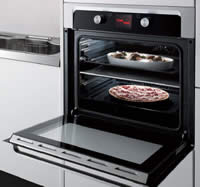Difference between Oven and Convection Oven
Key Difference: An oven is a thermally insulated chamber that is used for heating, baking or drying a substance. It is most commonly used for cooking. Convection ovens are actually ovens similar to the original ones with an extra feature, fans.
Ovens play an important part in today’s world, they are a necessity. We require ovens in order to cook and feed ourselves. Ovens have been in existence since the invention of fire and have been used for various purposes such as cooking, masonry and forging.
 An oven is a thermally insulated chamber that is used for heating, baking or drying a substance. It is most commonly used for cooking. The earliest ovens can been dated back to 29,000 BC in Central Europe, where it was used for roasting, boiling and most commonly cooking mammoths. As the technology continued to increase, the construction of ovens got better and better. The advancement included creating an actual oven, making them portable, allowing for different types of cooking such as boiling, roasting, etc.
An oven is a thermally insulated chamber that is used for heating, baking or drying a substance. It is most commonly used for cooking. The earliest ovens can been dated back to 29,000 BC in Central Europe, where it was used for roasting, boiling and most commonly cooking mammoths. As the technology continued to increase, the construction of ovens got better and better. The advancement included creating an actual oven, making them portable, allowing for different types of cooking such as boiling, roasting, etc.
Findings from the Indus Valley Civilization show, in addition to cooking, these ovens were also used to create baked brick to construct sewers and pottery. These old ovens were powered by fire, wooden twigs and grass. The advancement of technology also saw ovens being powered by natural gas, wood, coal and electricity. Other advancements saw ovens with fire vents, ventilation windows and chimneys. Various different types of ovens include earth oven, ceramic oven, gas oven, electric oven, microwave oven and convection oven.
The breakthrough in ovens was seen with the development of the gas ovens, invented in the early 1900s; followed by the electric ovens, invented in the late 19th century, and the microwave ovens. The electric ovens, eliminates the need for dangerous flammable gas, while using resistor heating coils in order to provide heat. The microwave oven uses microwaves in order to produce heat. The microwaves excite the molecules of an object causing friction and producing heat. These ovens, excluding the microwave oven are known as conventional ovens.

Convection ovens are actually ovens similar to the original ones with an extra feature, fans. The only major difference between the conventional ovens and convection ovens are the fans. Convection ovens are also powered by gas or electricity. The fans allow the heat provided by the gas burners or electric coils to circulate throughout the enclosed space. Convection style cooking was discovered in the 1960s, but did not gain popularity until recently.
The purpose of installing fans in the convection ovens is to allow the fans to push the air to all the parts of oven creating a stable temperature for even cooking. Convection ovens have been known to provide a more even cooking, along with having the ability to retain juices when roasting meat. The even cooking and temperature reduces the cooking time, allowing the food to cook faster and saves electricity or gas. However, it has said to dry out baked goods such as cookies, bread and cake. Today, convection ovens are available as an added feature to normal gas, electric or microwave ovens.
|
|
Ovens |
Convection Ovens |
|
Runs on |
Electricity, natural gas (propane, butane, LPG), wood, etc. |
Gas or electric |
|
Price |
The price of the oven depends on initial set up charges and what it runs on. |
Convection ovens are more costly compared to normal ones; especially if they come as a feature included in gas and electric ovens. |
|
Heating |
Heating depends on the type of oven. While gas ovens heat up fast, electric ovens take a while in order to heat up. |
Convection ovens are powered by fans which help circulate hot air throughout the oven, causing it to heat faster and provide a more even cooking. |
|
Cooking Time |
Cooking time is greater in conventional ovens. |
Cooking time is reduced due to air flow. |
|
Economical |
Again the economic factor depends on the type of ovens. Gas ovens are commonly more economic in the long run. Electric ovens are more costly in the long run as electricity is more costly compared to natural gas. |
In the long run convection ovens are better as they reduce the cooking time and save on energy and natural gas bills. |
|
Heat distribution |
Gas ovens distribute heat unevenly (more heat from top), while electric ovens have a more even heat distribution. |
A more even heat distribution as the fans allow the hot air to travel in all directions in the oven. |
|
Temperature Management |
Temperature is easier to manage in almost all off the ovens. |
Temperature is really easy to manage as the fans automatically manage the set temperature. |
|
Burners |
Runs on burners, coils, wood, coal, etc. |
Runs on burners, or electric coils. |
|
Benefits |
The benefit of each oven depends on the type of oven it is. While electric ovens are easier to clean and cheaper to install; gas ovens are faster to heat up and are cheaper in the long run. |
Convection ovens are more economical in the long run, have a more even heating, reduces the cooking time and has an option to switch back to conventional oven setting. |
|
Limitations |
Electric: expensive in the long run, slow heating, useless during power outage; Gas: harder to clean, expensive repairs, danger of leakage, expensive installation. |
Expensive to purchase, not good for baking goods that require moisture. In case adhering to a certain recipe the temperature will need to be adjusted according to convection oven. |
Image Courtesy: jerrysappliancerepairnova.com, appliancist.com









Add new comment